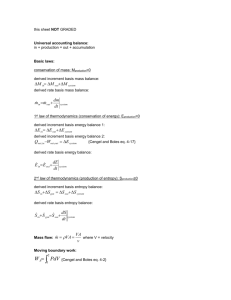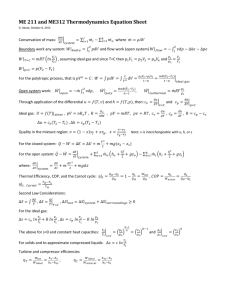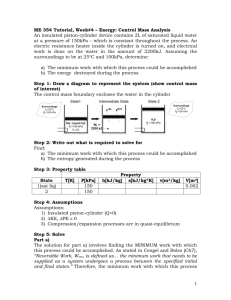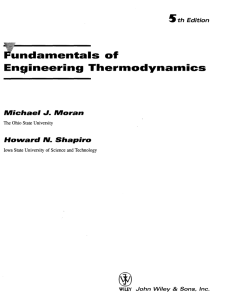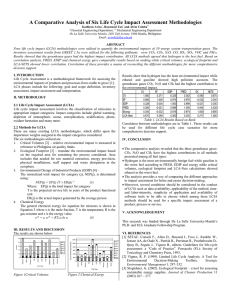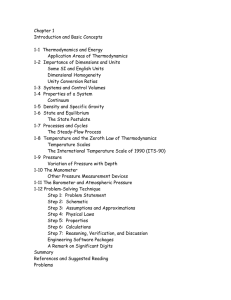Slides of Cavendish Talk - Nottingham Harmonic Choir
advertisement
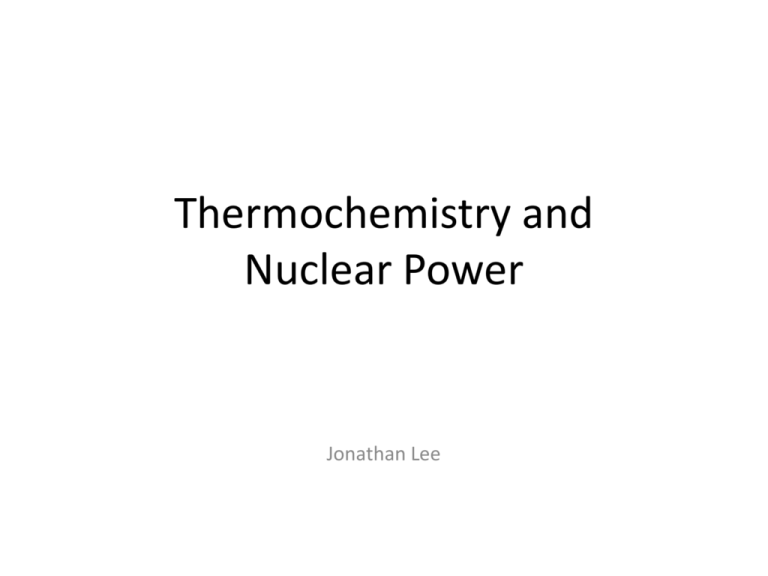
Thermochemistry and Nuclear Power Jonathan Lee Thermodynamics First 2 laws provide the main constraints on any power system. We can’t produce energy or reduce entropy. Exergy is the useful measure of efficiency. Entropy is related to temperature. High temperature implies less entropy. In a Thermal system We want high output exergy for high efficiency. If we want low grade energy, we should get the required entropy from the environment. Hence heat pumps for heating if possible. Chemistry Reactions occur spontaneously when the entropy change involved is positive. Chemical bonds tie up both entropy and energy. The ratio of entropy to energy in chemical bonds is higher, so for the same exergy input more “energy” can be given out. Electrical Grids Need to balance supply to demand Many renewables are poor on this, Solar and Wind particularly so. A grid needs to absorb fluctuations and have backup generation Why this is a problem Normal renewables are very variable. In the 2006 California heatwave, the aggregate state generation was under 4% rated capacity for a week. According to E.On Netz, German wind produced between 0.1% and 32% of daily peak load in 2003, and 0.2% to 38% in 2004. Backup generation is needed. E.On Netz data also shows changes of 10-16MW/min occur for long periods (several hours) So Backup must be very responsive Possible solutions Energy storage of some variety - Pumped Storage, Molten Salt (≈0.1MWh/ton) Altering other production to match quickly - Pumped Storage, Gas Turbines - For most thermal plants, altering production quickly isn’t possible. Why we still need Hydrocarbons Lots of uses, especially if people don’t want to change lifestyles: • Plastics • Lubricants • Feedstocks in other industry (Haber-Bosch) • Aviation • Arguably cars Transport PHEV/BEV are limited by global lithium supply. Vehicle production is roughly x10 too high. NiMH/Lead Acids can be used, but heavier and less efficient. Greening fuels cleans things up now. Swapping to new vehicles will take at least 15 years. How to make them? Fisher-Tropsch synthesis: H2 + COx → Oxy-hydrocarbons + H2O Clearly this needs Hydrogen. Related reactions can form CO or C as output from CO2. Biology Limited by low temperature and lack of choices. Making Hydrogen Electrolysis converts low entropy electricity to higher entropy chemistry. 30-45% efficient. High Temperature Electrolysis is a little better, as some energy comes from heat. Thermochemistry: 65% total exergy efficiency is possible without combined processes or particular cunning. Sulphur Iodine Process High temperatures – >800°C at one point Multiple reactions at different temperatures Efficiency limited by need to drop temperature between stages Combined Hydrogen and Power (CHyP) Consider using the thermal gradient between stages to drive electrical generation. All exergy in the system can now be used. Exergy either heats chemicals, and is scavenged as they are cooled, or it drives electrical generation. Responsiveness Under CHyP, whatever doesn’t go into the S-I process produces electricity. The exergy consumed in S-I can be varied simply by throttling flow rates in the heat exchangers, at a slight cost in overall efficiency. Hence electrical production is decoupled from energy production in the plant. Generalisation There is nothing special about S-I in this. Any endothermic thermo-chemistry works, Eg • Haber-Bosch – Both H2 use and heating. • Blast furnaces – Injecting hot CO • Cement Kilns – Simple heat. Conclusion on energy If we have a high temperature heat source, we can produce hydrogen for Fischer-Tropsch Generalised CHyP lets us use ‘baseline’ generators to handle short term fluctuations. This allows more renewable usage, if they’re economically viable. High Temperature Power Steam plants are limited to 600°C by the creep strength of steel. Gas turbines run hotter. If we want no CO2 output, then we need to capture and store or go nuclear. Problems with CCS imply nuclear Nuclear Power We can’t use steam to cool, and we want an unreactive coolant that doesn’t need pressure - Ionic salts are good, Fluorides in particular - LiF and BeF2 mixtures can run from 400°C to 1300°C without pressure Avoiding bomb materials and enrichment would be bonuses Thorium Cycle Naturally pure Th232 is bred to fissile U233 Thorium is 3 times more abundant, and all Th232 No enrichment, and U233 ends up with U232 contamination, so it’s unsuitable for weapons. The breeding can be done with thermal neutrons, so much easier to handle. <0.1 neutrons/fission excess in any design. Molten Salt Reactors Integrate the fuel into the primary coolant loop, as both will be molten and thus should be unreactive ionic salts. This lets you reprocess the fuel continuously. Hexafluoride volatility and distillation make the process straightforward. Fuel breeding External blanket of Thorium salts absorbs neutrons to produce fuel. Th232+n → Th233 → Pa233 (22m)→ U233 (27d) Further neutron absorption is bad – U234 isn’t fissile. In Chlorides, the Pa233 can be extracted trivially as PaCl4 is volatile. Hence essentially pure U233 can be extracted. Why do this? Long term waste output is low if reprocessing is continuous 0.1% of that of a light water reactor per unit power Most waste is short half life fission products. Waste is less radioactive than natural uranium ores after around 300 years. Avoiding separate coolant loops allows higher power density. Also helped by high fissile content of fuel. Smaller cores mean they’re easier to build and shield. Safety Small core and liquid fuel give lots of options. Fuel can be physically removed easily and with passive mechanisms, which prevents core overheats. First order stable with respect to power output and voids. The LFTR concept Liquid fluoride cooled, thorium breeder reactor. Optionally Chloride blanket to allow high purity fuel production High temperature allows high efficiency. Passively safe, and few neutrons emitted. Very little waste produced. LFTR-CHyP High temperature baseline power station being utilised to provide responsive power. Hydrogen for oxyhydrocarbon production or immediate industrial use. With CHP, desalination or other low temperature processes, exergetic efficiency is high. Large scale renewables become viable. Thank you for listening Any questions?
